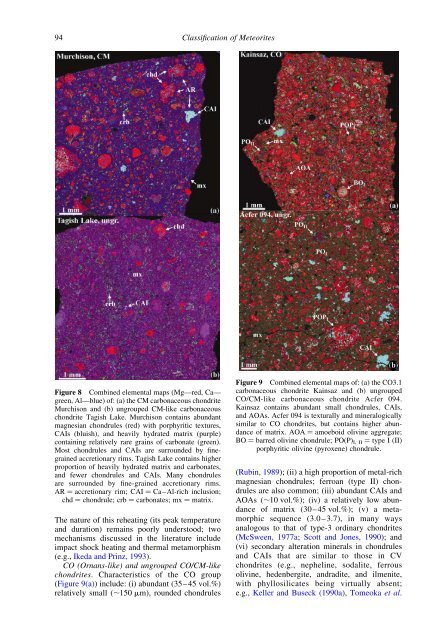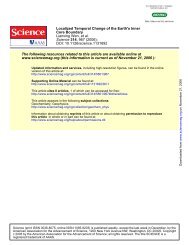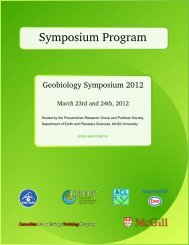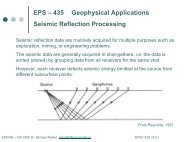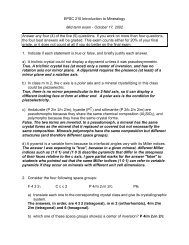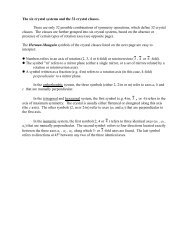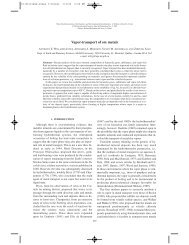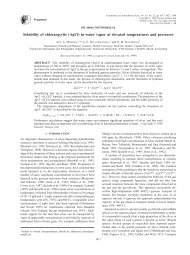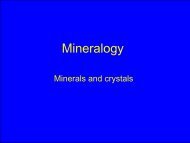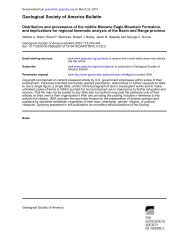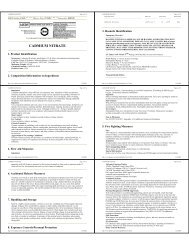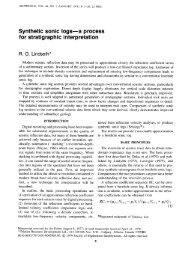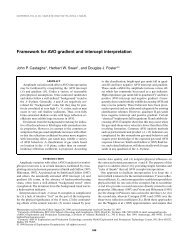05 Classification of.. - Department of Earth and Planetary Sciences
05 Classification of.. - Department of Earth and Planetary Sciences
05 Classification of.. - Department of Earth and Planetary Sciences
Create successful ePaper yourself
Turn your PDF publications into a flip-book with our unique Google optimized e-Paper software.
94<br />
<strong>Classification</strong> <strong>of</strong> Meteorites<br />
Figure 8 Combined elemental maps (Mg—red, Ca—<br />
green, Al—blue) <strong>of</strong>: (a) the CM carbonaceous chondrite<br />
Murchison <strong>and</strong> (b) ungrouped CM-like carbonaceous<br />
chondrite Tagish Lake. Murchison contains abundant<br />
magnesian chondrules (red) with porphyritic textures,<br />
CAIs (bluish), <strong>and</strong> heavily hydrated matrix (purple)<br />
containing relatively rare grains <strong>of</strong> carbonate (green).<br />
Most chondrules <strong>and</strong> CAIs are surrounded by finegrained<br />
accretionary rims. Tagish Lake contains higher<br />
proportion <strong>of</strong> heavily hydrated matrix <strong>and</strong> carbonates,<br />
<strong>and</strong> fewer chondrules <strong>and</strong> CAIs. Many chondrules<br />
are surrounded by fine-grained accretionary rims.<br />
AR ¼ accretionary rim; CAI ¼ Ca–Al-rich inclusion;<br />
chd ¼ chondrule; crb ¼ carbonates; mx ¼ matrix.<br />
The nature <strong>of</strong> this reheating (its peak temperature<br />
<strong>and</strong> duration) remains poorly understood; two<br />
mechanisms discussed in the literature include<br />
impact shock heating <strong>and</strong> thermal metamorphism<br />
(e.g., Ikeda <strong>and</strong> Prinz, 1993).<br />
CO (Ornans-like) <strong>and</strong> ungrouped CO/CM-like<br />
chondrites. Characteristics <strong>of</strong> the CO group<br />
(Figure 9(a)) include: (i) abundant (35–45 vol.%)<br />
relatively small (,150 mm), rounded chondrules<br />
Figure 9 Combined elemental maps <strong>of</strong>: (a) the CO3.1<br />
carbonaceous chondrite Kainsaz <strong>and</strong> (b) ungrouped<br />
CO/CM-like carbonaceous chondrite Acfer 094.<br />
Kainsaz contains abundant small chondrules, CAIs,<br />
<strong>and</strong> AOAs. Acfer 094 is texturally <strong>and</strong> mineralogically<br />
similar to CO chondrites, but contains higher abundance<br />
<strong>of</strong> matrix. AOA ¼ amoeboid olivine aggregate;<br />
BO ¼ barred olivine chondrule; PO(P) I, II ¼ type I (II)<br />
porphyritic olivine (pyroxene) chondrule.<br />
(Rubin, 1989); (ii) a high proportion <strong>of</strong> metal-rich<br />
magnesian chondrules; ferroan (type II) chondrules<br />
are also common; (iii) abundant CAIs <strong>and</strong><br />
AOAs (,10 vol.%); (iv) a relatively low abundance<br />
<strong>of</strong> matrix (30–45 vol.%); (v) a metamorphic<br />
sequence (3.0–3.7), in many ways<br />
analogous to that <strong>of</strong> type-3 ordinary chondrites<br />
(McSween, 1977a; Scott <strong>and</strong> Jones, 1990); <strong>and</strong><br />
(vi) secondary alteration minerals in chondrules<br />
<strong>and</strong> CAIs that are similar to those in CV<br />
chondrites (e.g., nepheline, sodalite, ferrous<br />
olivine, hedenbergite, <strong>and</strong>radite, <strong>and</strong> ilmenite,<br />
with phyllosilicates being virtually absent;<br />
e.g., Keller <strong>and</strong> Buseck (1990a), Tomeoka et al.


